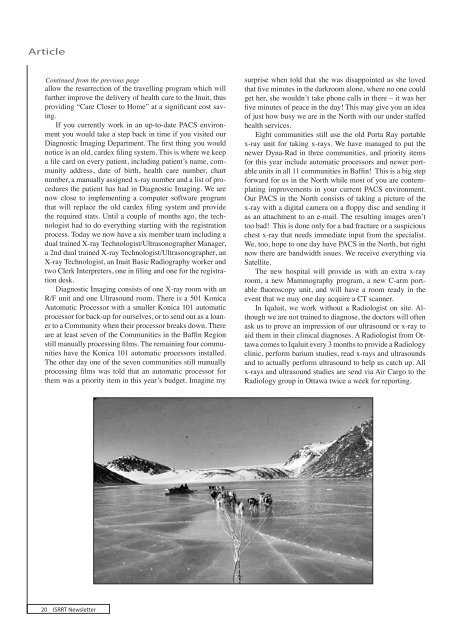ISRRT_August_2006
You also want an ePaper? Increase the reach of your titles
YUMPU automatically turns print PDFs into web optimized ePapers that Google loves.
Article<br />
Continued from the previous page<br />
allow the resurrection of the travelling program which will<br />
further improve the delivery of health care to the Inuit, thus<br />
providing “Care Closer to Home” at a significant cost saving.<br />
If you currently work in an up-to-date PACS environment<br />
you would take a step back in time if you visited our<br />
Diagnostic Imaging Department. The first thing you would<br />
notice is an old, cardex filing system. This is where we keep<br />
a file card on every patient, including patient’s name, community<br />
address, date of birth, health care number, chart<br />
number, a manually assigned x-ray number and a list of procedures<br />
the patient has had in Diagnostic Imaging. We are<br />
now close to implementing a computer software program<br />
that will replace the old cardex filing system and provide<br />
the required stats. Until a couple of months ago, the technologist<br />
had to do everything starting with the registration<br />
process. Today we now have a six member team including a<br />
dual trained X-ray Technologist/Ultrasonographer Manager,<br />
a 2nd dual trained X-ray Technologist/Ultrasonographer, an<br />
X-ray Technologist, an Inuit Basic Radiography worker and<br />
two Clerk Interpreters, one in filing and one for the registration<br />
desk.<br />
Diagnostic Imaging consists of one X-ray room with an<br />
R/F unit and one Ultrasound room. There is a 501 Konica<br />
Automatic Processor with a smaller Konica 101 automatic<br />
processor for back-up for ourselves, or to send out as a loaner<br />
to a Community when their processor breaks down. There<br />
are at least seven of the Communities in the Baffin Region<br />
still manually processing films. The remaining four communities<br />
have the Konica 101 automatic processors installed.<br />
The other day one of the seven communities still manually<br />
processing films was told that an automatic processor for<br />
them was a priority item in this year’s budget. Imagine my<br />
surprise when told that she was disappointed as she loved<br />
that five minutes in the darkroom alone, where no one could<br />
get her, she wouldn’t take phone calls in there – it was her<br />
five minutes of peace in the day! This may give you an idea<br />
of just how busy we are in the North with our under staffed<br />
health services.<br />
Eight communities still use the old Porta Ray portable<br />
x-ray unit for taking x-rays. We have managed to put the<br />
newer Dyna-Rad in three communities, and priority items<br />
for this year include automatic processors and newer portable<br />
units in all 11 communities in Baffin! This is a big step<br />
forward for us in the North while most of you are contemplating<br />
improvements in your current PACS environment.<br />
Our PACS in the North consists of taking a picture of the<br />
x-ray with a digital camera on a floppy disc and sending it<br />
as an attachment to an e-mail. The resulting images aren’t<br />
too bad! This is done only for a bad fracture or a suspicious<br />
chest x-ray that needs immediate input from the specialist.<br />
We, too, hope to one day have PACS in the North, but right<br />
now there are bandwidth issues. We receive everything via<br />
Satellite.<br />
The new hospital will provide us with an extra x-ray<br />
room, a new Mammography program, a new C-arm portable<br />
fluoroscopy unit, and will have a room ready in the<br />
event that we may one day acquire a CT scanner.<br />
In Iqaluit, we work without a Radiologist on site. Although<br />
we are not trained to diagnose, the doctors will often<br />
ask us to prove an impression of our ultrasound or x-ray to<br />
aid them in their clinical diagnoses. A Radiologist from Ottawa<br />
comes to Iqaluit every 3 months to provide a Radiology<br />
clinic, perform barium studies, read x-rays and ultrasounds<br />
and to actually perform ultrasound to help us catch up. All<br />
x-rays and ultrasound studies are send via Air Cargo to the<br />
Radiology group in Ottawa twice a week for reporting.<br />
20 <strong>ISRRT</strong> Newsletter


















